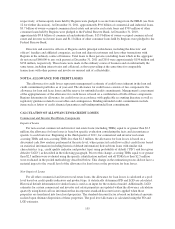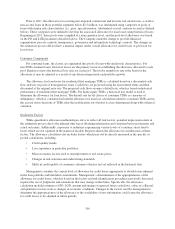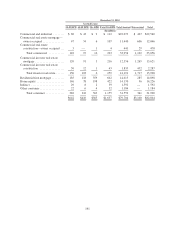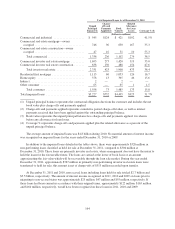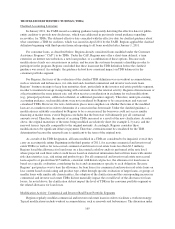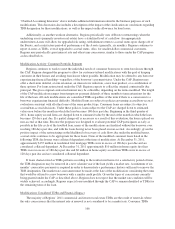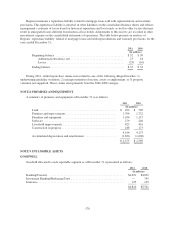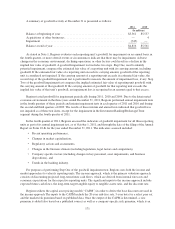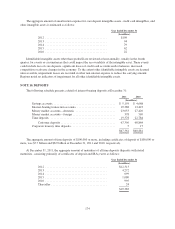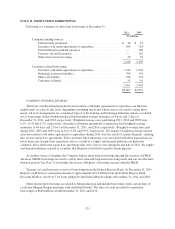Regions Bank 2011 Annual Report Download - page 189
Download and view the complete annual report
Please find page 189 of the 2011 Regions Bank annual report below. You can navigate through the pages in the report by either clicking on the pages listed below, or by using the keyword search tool below to find specific information within the annual report.
TROUBLED DEBT RESTRUCTURINGS (TDRs)
Clarified Accounting Literature
In January 2011, the FASB issued accounting guidance temporarily deferring the effective date for public-
entity creditors to provide new disclosures, which were addressed in previously issued guidance regarding
receivables, for TDRs. The deferred effective date coincided with the effective date for clarified guidance about
what constitutes a TDR for creditors, which was issued in April 2011 by the FASB. Regions applied the clarified
definition beginning with third quarter financial reporting to all loans modified after January 1, 2011.
For consumer loans, as described below, Regions already considered loans modified under the Customer
Assistance Program (“CAP”) to be TDRs. Under the CAP, Regions may offer a short-term deferral, a term
extension, an interest rate reduction, a new loan product, or a combination of these options. Because such
modifications clearly are concessionary in nature, and because the customer documents a hardship in order to
participate in the program, Regions concluded that these loans met the TDR definition before the clarified
guidance was issued. Accordingly, the guidance did not have a material impact on TDR balances for the
consumer portfolio segment.
For Regions, the focus of the evaluation of the clarified TDR definition was on workout accommodations,
such as renewals and forbearances, for criticized and classified commercial and investor real estate loans.
Regions’ business strategy to keep loan maturities short, particularly in the investor real estate portfolio segment,
in order to maintain leverage in negotiating with customers drove the renewal activity. Regions often increases or
at least maintains the same interest rate, and often receives consideration in exchange for such modifications
(e.g., principal paydowns, additional collateral, or additional guarantor support). Therefore, under pre-existing
accounting guidance, such modifications were not considered by Regions to be concessionary and were not
considered TDRs. However, the new clarification places more emphasis on whether the terms of the modified
loan are at a market rate in order to determine if a concession has been made. Under the clarified guidance, a
modification is refutably considered by Regions to be a concession if the borrower could not access similar
financing at market terms, even if Regions concludes that the borrower will ultimately pay all contractual
amounts owed. Therefore, the amount of accruing TDRs increased as a result of the new clarification. As noted
above, the original maturities of the notes being modified are relatively short (for example 2-3 years), and the
renewed term is typically comparable to the original maturity. Accordingly, Regions considers these
modifications to be significant delays in payment. Therefore, extensions must be considered for the TDR
determination because the renewed term is significant to the term of the original note.
As a result of the TDR designation, all loans modified in a TDR are considered to be impaired, even if they
carry an accruing risk rating. Beginning in the third quarter of 2011, for accruing commercial and investor real
estate TDRs (as well as for non-accrual commercial and investor real estate loans less than $2.5 million),
Regions based the allowance for loan losses on a discounted cash flow analysis performed at the note level,
where projected cash flows reflect credit losses based on statistical information derived from loans with similar
risk characteristics (e.g., risk rating and product type). For all commercial and investor real estate non-accrual
loans equal to or greater than $2.5 million, consistent with historical practice, the allowance for loan losses is
based on a specific evaluation, considering the facts and circumstances specific to each obligation. Because
Regions’ past practice was to base the allowance for loan losses for commercial and investor real estate loans on
loss content based on risk rating and product type, either through specific evaluation of larger loans, or groups of
smaller loans with similar risk characteristics, the adoption of the clarification and the corresponding increase in
commercial and investor real estate TDRs did not materially impact the overall level of the allowance for loan
losses. As noted above, the clarification did not impact the level of TDRs in the consumer portfolio segment or
the related allowance for loan losses.
Modification Activity: Commercial and Investor Real Estate Portfolio Segments
Regions regularly modifies commercial and investor real estate loans in order to facilitate a workout strategy.
Typical modifications include workout accommodations, such as renewals and forbearances. The discussion under
165


